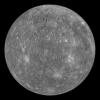Main menu
You are here
Mercury Transit
 Celestial transits-where a celestial body is seen to pass across the solar disk from the perspective of the Earth-are relatively rare events. The planet Mercury undergoes around 13 transits a century, and Venus has a pair of transits approximately every 120 years. In 2012 the SWAP EUV imager on the PROBA2 satellite successfully observed a Venus transit of the Sun. On May 9, 2016, it was Mercury's turn! The Mercury transit was seen from Earth starting at 11:13 UT and ending at 18:42 UT. The total transit time was around 7 hours and 30 minutes.
Celestial transits-where a celestial body is seen to pass across the solar disk from the perspective of the Earth-are relatively rare events. The planet Mercury undergoes around 13 transits a century, and Venus has a pair of transits approximately every 120 years. In 2012 the SWAP EUV imager on the PROBA2 satellite successfully observed a Venus transit of the Sun. On May 9, 2016, it was Mercury's turn! The Mercury transit was seen from Earth starting at 11:13 UT and ending at 18:42 UT. The total transit time was around 7 hours and 30 minutes.
What did we expect to see in SWAP observations? SWAP is an EUV telescope onboard the ESA PROBA2 satelite, it observes the Sun at roughly 1 million degrees from orbit around the Earth. Mercury is expected to be pictured as a small black disk crossing the face of the Sun, which would be seen as roughly 4 pixels in diameter. The PROBA2 team created a simulation of what SWAP was expected to see, which is shown in the video below. This simulation illustrates the path of Mercury as it crosses the Sun from the perspective of SWAP on PROBA2. The path of Mercury appears to 'wobble' as it crosses the Sun, but this is an artificial effect created by parallax from the changing perspective of Mercury in the PROBA2 field-of-view as the spacecraft orbits the Earth.
Movie 1. Simulation of Mercury's path in the SWAP field-of-view.
The number in the upper right hand corner of Movie 1 is a measure of the 'tangential height', which is the altitude of the point in the optical path that is closest to the Earth’s surface. What does this mean? - As the satellite orbits, there are times when the Earth is closer to the SWAP field of view, and times when it is further away, this number shows that distance. As a comparison imagine taking a video of a distant object when sat on a Ferris wheel, there will be times when the Earth is closer to your camera field of view (near the bottom of the Ferris wheel), and times when it is further away (near the top).
Now, PROBA2 does not orbit in a circle on top of the Earth, but goes around the Earth. This orbit produces periods when the Earth is closer to the SWAP field of view, in fact there are short periods in the orbit when the Earth passes in front of the SWAP field of view, creating eclipses (also known as occultations) of the Sun from the perspective of the satellite. This measure of altitude is an important parameter during PROBA2's occultation period, when the instruments onboard observe the Sun through the Earth's atmosphere. However, occultation seasons are normally experienced around December, and will not affect our view of the Mercury transit.
Due to the relative sizes and brightness of Mercury (4879.4 km) and the Sun (696300 km) it is hard to spot Mercury in SWAPs images. Mercury was seen as a mere 12 arcsec in diameter (approximately 4 pixels in diameter in our 1024 x 1024 pixel field of view). Mercury entered the field of view of SWAP at 08:14 UT and left it at 21:47 UT. The planet can probably most easily be found when it seemingly touches the solar disk at 11:13 UT (left limb) and 18:42 (right), or when it travels over bright patches in the solar atmosphere. In preparation of the event, the PROBA2 team made high cadence image campaigns (lots of images) throughout the day. These images are shown below.
Movie 2. Observations of the Mercury transit by SWAP.
We collected all of our SWAP data products for this Mercury transit in one place: http://proba2.oma.be/Events/2016-May-09-MercuryTransit/. SWAP images were added here as soon as they were available. Due to PROBA2's orbit, images are stored onboard and downloaded approximately every 2 hours when the spacecraft passes over one of our two ground stations (one situated in the Arctic and the other in Belgium).

